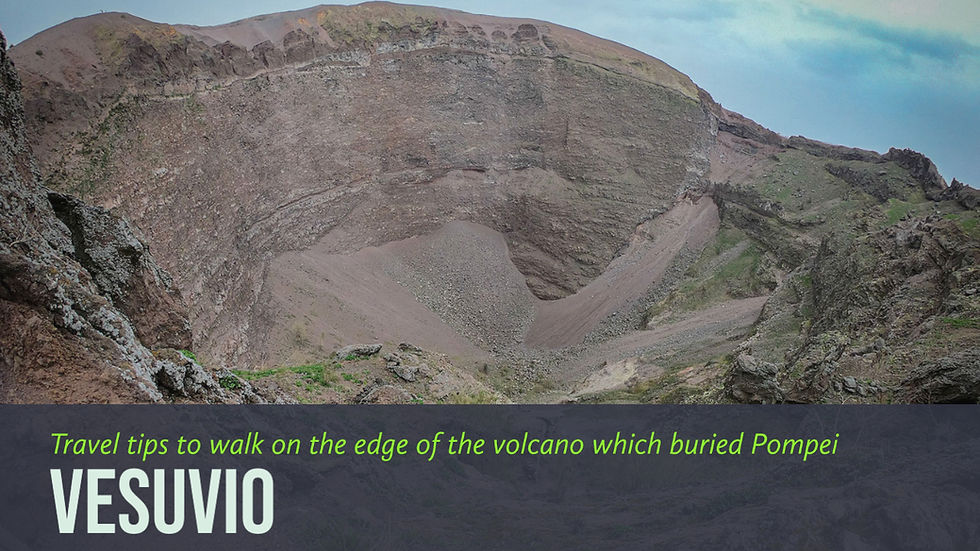Vesuvius: on the edge of the volcano
- twointour
- May 12, 2019
- 4 min read
Updated: Dec 26, 2023
Looking for quick tips to visit one the most amazing volcanoes of Italy? Check out this article and prepare yourself for an amazing walk on the edge of the crater

"Adopt the pace of nature: her secret is patience!" - R.W. Emerson
Mount Vesuvius is an Italian active volcano mostly know for the disastrous eruption in 79 AD which buried Pompeii, Ercolano and other roman settlements.
Today it is part of the Vesuvius National Park (more info at www.parconazionaledelvesuvio.it) and it has been listed in the Unesco’s Mab Reserve due to the presence of naturalistic, geological, volcanological and archaeological aspects of exceptional historical importance.
The peak of the volcano stands about 1280 meters and it can be reached by a breathtaking path easily accessible for everyone.
Before reading the article and the top tips to organize this adventure, check out our short video below
Getting to the Volcano:
The easiest way to get to the Mount Vesuvius National Park is by car, taking the A3 highway up to Herculaneum exit (don't miss and our post about this amazing archaeological site), and following the signs for "Osservatorio Vesuviano". This Observatory is the oldest observatory in the world, managed by the National Institute of Geophysics and Volcanology, and it is responsible for monitoring the Vesuvius.
The road is curvy and some stretches are a bit narrow but you can get up to the parking area without issues driving carefully.
Once passed the Observatory there is a dedicated unstaffed parking area (5 EUR cost for all day) where you can leave your car.
Unfortunately the path to the Volcano does not start from here (there is another small parking area more close to the ticket office but it is dedicated to private bus only) but some Shuttles (additional cost of 2 EUR/person round trip) can quickly bring you there avoiding you a useless effort and saving energy for the main path! Anyway you can decide to take this additional walk just following the road.
In case you prefer to use the public transportation probably the best option is to reach Pompeii and to get the EAV bus right in front of the "Circumvesuviana" train stop Villa dei Misteri (visit the site https://www.eavsrl.it/web/file/pompei-vesuviopdf-0 to check the availability and the timetable) which will bring you directly to the National Park ticket office.
The path to the crater:
Once bought the ticket (10 EUR) you can start the climb autonomously following the main trail (trail number 5 called "Il Gran Cono") at an altitude of 1,000 metres above sea level.
The trail offers immediately splendid views of the northern side of Mount Somma (an ancient caldera) and the so called Valle del Gigante right below. Getting to the top of the crater has low difficulty and it takes approximately 1 hour but of course depends on your pace
The path is marked on the volcanic products like ashes and lapilli and some small flows produced during the recent eruption of 1944 therefore we suggest you to wear comfortable shoes (better if specific for trekking) and sporty clothes, possibly windproof.
Before arriving at the top of the volcano, several breathtaking views along the way allow you to admire inside the big elliptical shape crater (approx. 580 meters), and if you are lucky you can also spot some fumaroles which testimony the activity of this volcano.
Continuing along the path, you can see the southern coast of the gulf up to Sorrento and during sunny clear days it is possible also to spot Capri island. The view from there is really incredible, so don't forget to take as many shots you can!
The 79 AD eruption:
Once you get to the top of the volcano it is impossible not to feel the power of the nature or trying to imagine how devastating was the eruption which buried for centuries the roman sites of Pompeii and Hercolaneum under tens of meters of volcanic materials.
Scientists estimates that the power of the Vesuvius eruption was comparable to a hundred thousand times the energy released by the Hiroshima bombing and we can learn the dynamic of the eruption directly from the letters of Pliny the Younger, a roman witness of the destruction of the area.
The 79 AD Vesuvius eruption was not characterized by slow moving lava flows; on the contrary it was a terrible explosion which took Romans people completely astonished and unprepared to the catastrophic event.
"..The chariots, which we had ordered to be drawn out, were so agitated backwards and forwards, though upon the most level ground, that we could not keep them steady, even by supporting them with large stones. The sea seemed to roll back upon itself, and to he driven from its banks by the convulsive motion of the earth; it is certain at least the shore was considerably enlarged, and several sea animals were left upon it. On the other side, a black and dreadful cloud, broken with rapid, zigzag flashes, revealed behind it variously shaped masses of flame: these last were like sheet-lightning, but much larger..".
The column of ashes and other volcanic materials was probably 14 Km high in the sky obscuring the sunlight, a very fearing thought when you are few meters from an active crater!
To discover more about this place, have a look to our posts and stories dedicated to Vesuvio dated May 2019 on our Instagram page @2intour
Did you enjoy our article? Read the other articles and for more photos and videos follow our IG page @2intour
Komentarai